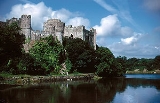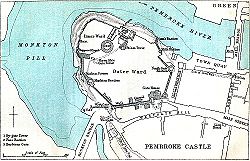
Siege of Pembroke
Encyclopedia
The Siege of Pembroke took place in 1648 during the Second English Civil War
.
troops in Wales, who had not been paid for a long time, staged a Royalist
rebellion under the command of the Colonel John Poyer
, the Parliamentarian Governor of Pembroke Castle
. He was joined by Major-General Rowland Laugharne
, his district commander, and Colonel Rice Powell
. After the failure of his pre-emptive strike against the small Parliamentarian army of Colonel Thomas Horton at the Battle of St. Fagans
, Laugharne retreated with what was left of his army to join Colonel Poyer at Pembroke
.
and laid siege to Tenby Castle
which was held by about 500 Royalists under the command of Colonel Rice Powell. Oliver Cromwell
with another Parliamentarian army consisting of three regiments of foot and two of horse had reached Gloucester
on the day that the Royalist army was routed at the Battle of St. Fagans and proceeded to cross the south Welsh border shortly afterwards. He left Colonel Isaac Ewer
in command of a small force to besiege the Royalist garrison of Chepstow Castle
which was under the command of Sir Nicholas Kemeys and pressed on to join Horton at Tenby
arriving on 15 May. Leaving Horton with enough men to deal with Powel, Cromwell marched the rest of the army to lay siege to Pembroke.
Kemeys was killed when Chepstow Castle was stormed on 25 May, and Powel was taken prisoner when he surrendered Tenby Castle to Horton on 31 May, but Pembroke Castle was a very strong medieval fortress which could not be taken as quickly. It stood on a rocky promontory surrounded on three sides by the sea, and on the landward side its defences consisted of a deep ditch and walls up to 20 feet (6.1 m) thick.
 Ships carrying siege artillery to Cromwell were forced back up the Bristol Channel
Ships carrying siege artillery to Cromwell were forced back up the Bristol Channel
to Gloucester by storms, so Cromwell tried a frontal assault. It failed because the ladders used to escalade
the walls were too short. The defenders managed to surprise the besiegers in a sudden sortie
, killing thirty of the besiegers and damaging the circumvallation. The siege guns arrived in mid-June but over the next month they made little impact on the thick curtain walls.
Eventually, the siege ended when Cromwell's forces discovered the conduit pipe which delivered water to the castle, and cut off the defenders' water supply. Poyer and Laugharne were forced to surrender on 11 July.
Cromwell then ordered the castle slighted
so that it could never again be used as a military fortress. Laugharne, Poyer and Powell were taken to London, tried and sentenced to death, but Poyer alone was executed on 25 April 1649, being the victim selected by lot.
Second English Civil War
The Second English Civil War was the second of three wars known as the English Civil War which refers to the series of armed conflicts and political machinations which took place between Parliamentarians and Royalists from 1642 until 1652 and also include the First English Civil War and the...
.
Background
In April 1648, ParliamentarianRoundhead
"Roundhead" was the nickname given to the supporters of the Parliament during the English Civil War. Also known as Parliamentarians, they fought against King Charles I and his supporters, the Cavaliers , who claimed absolute power and the divine right of kings...
troops in Wales, who had not been paid for a long time, staged a Royalist
Cavalier
Cavalier was the name used by Parliamentarians for a Royalist supporter of King Charles I and son Charles II during the English Civil War, the Interregnum, and the Restoration...
rebellion under the command of the Colonel John Poyer
John Poyer
John Poyer was a soldier in the Parliamentary army during the English Civil War in South Wales. He later rebelled and was executed for treason.- Background :...
, the Parliamentarian Governor of Pembroke Castle
Pembroke Castle
Pembroke Castle is a medieval castle in Pembroke, West Wales. Standing beside the River Cleddau, it underwent major restoration work in the early 20th century. The castle was the original seat of the Earldom of Pembroke....
. He was joined by Major-General Rowland Laugharne
Rowland Laugharne
Major General Rowland Laugharne was a soldier in the English Civil War.His family came from St. Brides House, Pembrokeshire, Wales.Major-General Laugharne, Parliament's commander in south Wales during the First Civil War, sided with the insurgents and took command of the rebel army...
, his district commander, and Colonel Rice Powell
Rice Powell
Rice Powell was a Colonel in the Parliamentary army during the First English Civil War. In the Second English Civil War he allied himself with the Royalist cause. English Civil Wars. He fought in South Wales and played a significant part in events between 1642 and 1649 including a senior role...
. After the failure of his pre-emptive strike against the small Parliamentarian army of Colonel Thomas Horton at the Battle of St. Fagans
Battle of St. Fagans
The Battle of St. Fagans was a pitched battle in the Second English Civil War in 1648. A detachment from the New Model Army defeated an army of former Parliamentarian soldiers who had rebelled and were now fighting against Parliament.-Background:...
, Laugharne retreated with what was left of his army to join Colonel Poyer at Pembroke
Pembroke, Pembrokeshire
Pembroke is an historic settlement and former county town of Pembrokeshire in west Wales. The town and the county derive their name from that of the cantref of Penfro: Pen = "head" or "end", and bro = "region", "country", "land", and so it means essentially "Land's End".-History:The main point of...
.
Prelude
Colonel Horton marched his 3,000 well disciplined troops, about half of which were dragoons, west to TenbyTenby
Tenby is a walled seaside town in Pembrokeshire, South West Wales, lying on Carmarthen Bay.Notable features of Tenby include of sandy beaches; the 13th century medieval town walls, including the Five Arches barbican gatehouse ; 15th century St...
and laid siege to Tenby Castle
Tenby Castle
The ruins of Tenby Castle stand on a headland west of the town of Tenby, Pembrokeshire, Wales. The remaining structure stems from the 13th century but there are mentions of the castle dating back to 1153...
which was held by about 500 Royalists under the command of Colonel Rice Powell. Oliver Cromwell
Oliver Cromwell
Oliver Cromwell was an English military and political leader who overthrew the English monarchy and temporarily turned England into a republican Commonwealth, and served as Lord Protector of England, Scotland, and Ireland....
with another Parliamentarian army consisting of three regiments of foot and two of horse had reached Gloucester
Gloucester
Gloucester is a city, district and county town of Gloucestershire in the South West region of England. Gloucester lies close to the Welsh border, and on the River Severn, approximately north-east of Bristol, and south-southwest of Birmingham....
on the day that the Royalist army was routed at the Battle of St. Fagans and proceeded to cross the south Welsh border shortly afterwards. He left Colonel Isaac Ewer
Isaac Ewer
Isaac Ewer was an English soldier and one of the Regicides of King Charles I of England.-Biography:He was probably born in Essex; in his will he describes himself as of Hatfield Broad Oak and before the Civil War was "but a serving-man"....
in command of a small force to besiege the Royalist garrison of Chepstow Castle
Chepstow Castle
Chepstow Castle , located in Chepstow, Monmouthshire in Wales, on top of cliffs overlooking the River Wye, is the oldest surviving post-Roman stone fortification in Britain...
which was under the command of Sir Nicholas Kemeys and pressed on to join Horton at Tenby
Tenby
Tenby is a walled seaside town in Pembrokeshire, South West Wales, lying on Carmarthen Bay.Notable features of Tenby include of sandy beaches; the 13th century medieval town walls, including the Five Arches barbican gatehouse ; 15th century St...
arriving on 15 May. Leaving Horton with enough men to deal with Powel, Cromwell marched the rest of the army to lay siege to Pembroke.
Kemeys was killed when Chepstow Castle was stormed on 25 May, and Powel was taken prisoner when he surrendered Tenby Castle to Horton on 31 May, but Pembroke Castle was a very strong medieval fortress which could not be taken as quickly. It stood on a rocky promontory surrounded on three sides by the sea, and on the landward side its defences consisted of a deep ditch and walls up to 20 feet (6.1 m) thick.
The Siege

Bristol Channel
The Bristol Channel is a major inlet in the island of Great Britain, separating South Wales from Devon and Somerset in South West England. It extends from the lower estuary of the River Severn to the North Atlantic Ocean...
to Gloucester by storms, so Cromwell tried a frontal assault. It failed because the ladders used to escalade
Escalade
Escalade is the act of scaling defensive walls or ramparts with the aid of ladders, and was a prominent feature of siege warfare in medieval times...
the walls were too short. The defenders managed to surprise the besiegers in a sudden sortie
Sortie
Sortie is a term for deployment or dispatch of one military unit, be it an aircraft, ship, or troops from a strongpoint. The sortie, whether by one or more aircraft or vessels, usually has a specific mission....
, killing thirty of the besiegers and damaging the circumvallation. The siege guns arrived in mid-June but over the next month they made little impact on the thick curtain walls.
Eventually, the siege ended when Cromwell's forces discovered the conduit pipe which delivered water to the castle, and cut off the defenders' water supply. Poyer and Laugharne were forced to surrender on 11 July.
Cromwell then ordered the castle slighted
Slighting
A slighting is the deliberate destruction, partial or complete, of a fortification without opposition. During the English Civil War this was to render it unusable as a fort.-Middle Ages:...
so that it could never again be used as a military fortress. Laugharne, Poyer and Powell were taken to London, tried and sentenced to death, but Poyer alone was executed on 25 April 1649, being the victim selected by lot.

